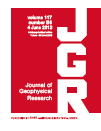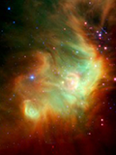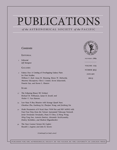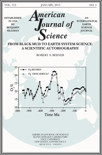
Planetary Science Journal
Scope & Guideline
Advancing Understanding: Your Gateway to Celestial Discoveries
Introduction
Aims and Scopes
- Planetary Geology and Surface Processes:
Research in this area encompasses the study of geological features, surface composition, and processes on various celestial bodies, including the Moon, Mars, and icy moons. This includes investigations into impact cratering, volcanic activity, and tectonic processes. - Planetary Atmospheres and Climate:
The journal publishes studies related to the atmospheres of planets and moons, focusing on their composition, dynamics, and climatic conditions. This includes modeling of atmospheric circulation, weather patterns, and the potential for habitability. - Astrobiology and Habitability:
A core area of focus is the potential for life beyond Earth, examining the conditions that might support life on other planets and moons. This includes research on subsurface oceans, organic chemistry, and biosignature detection. - Planetary Defense and Impact Studies:
With the increasing importance of planetary defense, studies related to asteroid impacts, mitigation strategies, and the dynamics of near-Earth objects are significant themes in the journal. - Exoplanet Research and Comparative Planetology:
The journal also explores the comparative aspects of planetary science, including studies on exoplanets, their atmospheres, and potential for life, drawing parallels with our solar system. - Remote Sensing and Instrumentation:
A significant emphasis is placed on the development and application of remote sensing technologies and instruments for planetary exploration, including spectrometers and imaging systems.
Trending and Emerging
- Icy Moon Exploration and Habitability:
Recent studies increasingly focus on icy moons like Europa and Enceladus, emphasizing their subsurface oceans and potential for hosting life. This trend highlights a growing interest in astrobiological implications and the potential for future missions. - Planetary Defense Initiatives:
With the DART mission and related studies, there is a marked increase in research dedicated to planetary defense, including impact hazard assessment and mitigation strategies for near-Earth objects. - Machine Learning and Data-Driven Approaches:
The application of machine learning and artificial intelligence in planetary science is on the rise, facilitating data analysis, modeling, and predictive studies across various planetary bodies. - In Situ Resource Utilization (ISRU):
Emerging research on ISRU emphasizes the potential for utilizing local resources on celestial bodies for future exploration missions, particularly for Mars and the Moon. - Interdisciplinary Approaches to Planetary Science:
There is a growing trend towards interdisciplinary studies that combine insights from geology, atmospheric science, astrobiology, and engineering, reflecting a holistic approach to understanding planetary systems.
Declining or Waning
- Traditional Planetary Formation Models:
Research focusing on classical models of planetary formation has seen a decline, as more innovative approaches and interdisciplinary studies emerge, integrating insights from astrobiology and comparative planetology. - Static Geological Surveys:
Studies that provide static geological surveys of planetary bodies without dynamic modeling or context have become less prevalent, as the field shifts towards more dynamic and interactive models. - Basic Mineralogical Studies:
Basic mineralogical studies of planetary materials are becoming less common, with a greater focus now on the implications of mineralogy for habitability and geological processes. - Conventional Astrobiological Hypotheses:
Traditional hypotheses regarding astrobiology, such as the exclusive focus on Earth-like conditions for life, are experiencing waning interest as researchers explore a broader range of environments and life potential.
Similar Journals

SPACE SCIENCE REVIEWS
Elevating Space Science Discourse GloballySPACE SCIENCE REVIEWS, published by Springer, is a premier interdisciplinary journal that has been at the forefront of space science research since its inception in 1962. With an impressive impact factor and a distinguished Q1 ranking in both Astronomy and Astrophysics, as well as Space and Planetary Science, it stands as a leading platform for the dissemination of cutting-edge research. The journal encompasses comprehensive reviews covering a diverse array of topics, from cosmic phenomena to planetary exploration, serving as a critical resource for researchers, professionals, and students alike. Although it operates primarily under a subscription model, its commitment to excellence and rigorous peer-review process ensures that each article meets the highest standards of scientific integrity. With its headquarters in the Netherlands, SPACE SCIENCE REVIEWS is positioned strategically to foster global collaboration in the field, making it an invaluable asset for anyone interested in the ever-evolving landscape of space science.

EARTH MOON AND PLANETS
Unveiling Celestial Mysteries: Insights from Earth to the Moon and PlanetsEARTH MOON AND PLANETS, published by Springer, serves as a vital platform for researchers and professionals in the interdisciplinary fields of astronomy, planetary science, and earth sciences. With an ISSN of 0167-9295 and E-ISSN of 1573-0794, this journal has been disseminating knowledge since 1984 and continues to provide valuable insights into the complexities of celestial bodies and their interactions. Although currently ranked in the Q4 quartile across its relevant categories, including Astronomy and Astrophysics, Earth and Planetary Sciences, and Space and Planetary Science, the journal remains committed to fostering academic discourse and innovation in its field. Located in the Netherlands, at VAN GODEWIJCKSTRAAT 30, 3311 GZ DORDRECHT, the journal offers an array of research articles designed to inspire scholarly exploration and collaboration. Despite not providing open access options, it nevertheless plays a significant role in shaping the discourse around planetary research and is essential reading for anyone looking to deepen their understanding of earth, moon, and planetary sciences.

JOURNAL OF GEOPHYSICAL RESEARCH-SOLID EARTH
Advancing Solid Earth Sciences for a Sustainable FutureJOURNAL OF GEOPHYSICAL RESEARCH-SOLID EARTH is a prestigious journal published by the American Geophysical Union, dedicated to advancing the study of solid Earth sciences. With an ISSN of 2169-9313 and E-ISSN of 2169-9356, it serves as a leading platform for rigorous research findings and innovative advancements within the fields of Earth and Planetary Sciences, Geochemistry and Petrology, Geophysics, and Space and Planetary Science. The journal has achieved an impressive Q1 quartile ranking across these categories, reflecting its high impact in the academic community and underscoring its role in influencing scientific discourse. Notably, it holds an esteemed position in Scopus, ranking 15th among 159 journals in Earth and Planetary Sciences (miscellaneous) as well as within the top 20 in several other geophysical domains. Researchers and practitioners are encouraged to contribute their work to this esteemed journal, which publishes comprehensive articles from 1979 to the present, thus providing a crucial repository of knowledge for those engaged in solid Earth research. Although it does not currently offer Open Access options, the journal's prestigious reputation ensures its articles reach a wide audience of academics, professionals, and students alike, fueling a deeper understanding of our planet's processes and challenges.

COSMIC RESEARCH
Fostering Innovation in Space Science StudiesCOSMIC RESEARCH is a prestigious academic journal dedicated to advancing the field of space science, particularly within the domains of aerospace engineering, astronomy, and planetary science. Published by MAIK NAUKA/INTERPERIODICA/SPRINGER, this journal has been a significant contributor to the scholarly discourse since its inception in 1968, with converged years showing robust publication activity until 2024. With a Q4 category ranking in various disciplines, including aerospace engineering, astronomy, and space science, the journal serves as a platform for disseminating innovative research and comprehensive reviews. Although not currently offering open access, COSMIC RESEARCH is renowned for its rigorous peer-review process, ensuring that only high-quality research is shared with the academic community. The journal's ISSN is 0010-9525 and its E-ISSN is 1608-3075. Researchers, professionals, and students alike can benefit from the insights and findings presented in this journal, making it an essential resource for anyone involved in the exploration of cosmic phenomena.

GEOMAGNETISM AND AERONOMY
Illuminating the Dynamics of Earth's Magnetic FieldGEOMAGNETISM AND AERONOMY, published by MAIK NAUKA/INTERPERIODICA/SPRINGER, is a prominent journal dedicated to advancing the fields of geophysics and planetary science. With ISSN 0016-7932 and E-ISSN 1555-645X, this journal serves as a critical platform for researchers to disseminate their findings on geomagnetic phenomena and aeronomical studies, fostering a deeper understanding of Earth's magnetic field dynamics and atmospheric interactions. Spanning publishing years from 1996 to 2024, it is categorized in the Q3 quartile for geophysics and Q4 for space and planetary science, reflecting its positioning within the academic landscape. Although not open access, readers and researchers can access valuable insights into geomagnetic and atmospheric research, contributing to ongoing discourse in these vital scientific domains. With a focus on innovative research, GEOMAGNETISM AND AERONOMY remains an essential resource for professionals and students aiming to deepen their expertise in Earth and planetary sciences.

Annual Review of Earth and Planetary Sciences
Advancing Knowledge in Earth and Planetary SciencesAnnual Review of Earth and Planetary Sciences is a leading scholarly journal published by Annual Reviews, dedicated to advancing our understanding of the dynamic processes governing the Earth and its celestial companions. With ISSN 0084-6597 and E-ISSN 1545-4495, this esteemed journal, established in 1976, has consistently provided comprehensive reviews that synthesize cutting-edge research across various disciplines, including astronomy, astrobiology, geology, and planetary science. Notably, the journal has achieved a remarkable position in the academic landscape, ranking in the Q1 quartile across multiple categories, including Astronomy and Astrophysics and Earth and Planetary Sciences, with Scopus rankings placing it at the forefront of these fields. The journal's commitment to facilitating open access to critical scientific advances, though not fully open, allows for maximum reach within the research community. Researchers, professionals, and students alike can benefit from the high-impact articles designed to foster collaboration and innovation within the fields of earth and planetary science.

PUBLICATIONS OF THE ASTRONOMICAL SOCIETY OF THE PACIFIC
Connecting Researchers to the Stars: Your Essential ResourcePublications of the Astronomical Society of the Pacific is a prestigious journal dedicated to advancing the fields of Astronomy and Astrophysics, as well as Space and Planetary Science. Published by IOP Publishing Ltd, this influential journal plays a critical role in disseminating groundbreaking research and innovative findings. With an impressive Q1 ranking in both related categories according to the 2023 metrics, it is recognized among the top journals in its field. As a vital resource for researchers, professionals, and students alike, the journal covers a range of topics relevant to current astronomical research from 1996 to 2024. Although it does not offer open access options, the journal is highly regarded in academic circles, evidenced by its competitive ranking in Scopus—20th in Astronomy and Astrophysics and 26th in Space and Planetary Science. This commitment to excellence ensures that it remains an essential platform for sharing the latest insights in the ever-evolving universe.

EARTH PLANETS AND SPACE
Exploring the Frontiers of Earth and BeyondEARTH PLANETS AND SPACE, published by Springer and based in Switzerland, is a distinguished journal that plays a pivotal role in advancing the fields of Earth and planetary sciences. With an impactful presence in both geology (Q1) and space and planetary science (Q2), this journal is increasingly recognized for its contributions to understanding complex geoscientific processes and extraterrestrial phenomena. The journal has been a vital resource for researchers since its inception in 1996 and is anticipated to continue this legacy until at least 2024. It ranks impressively within the Scopus database, holding the 53rd position out of 321 in Earth and Planetary Sciences for Geology and the 30th position out of 104 for Space and Planetary Science, reflecting a robust percentile standing of 83 and 71, respectively. With open access options available, EARTH PLANETS AND SPACE makes cutting-edge research more accessible to a global audience, fostering collaboration and innovation. This journal is essential for anyone seeking to deepen their knowledge or stay current with trends in Earth sciences and planetary exploration.

INTERNATIONAL JOURNAL OF EARTH SCIENCES
Transforming Understanding of Geological ProcessesINTERNATIONAL JOURNAL OF EARTH SCIENCES, published by Springer, is a leading journal in the field of Earth and Planetary Sciences, distinguished by its Q1 quartile ranking in the 2023 category of Earth and Planetary Sciences (miscellaneous). With an ISSN of 1437-3254 and an E-ISSN of 1437-3262, this journal has been a pivotal platform for researchers, academics, and practitioners since its inception in 1996. The journal's focus encompasses a broad range of topics within Earth sciences, making it a vital resource for contributions that enhance our understanding of geological processes, climate change, and planetary dynamics. The impact factor reflects its high standards and the significance of the research it publishes, ranking it in the 74th percentile among its peers as per Scopus. Furthermore, the journal offers Open Access options, facilitating the global dissemination of groundbreaking research. The editorial team is committed to advancing knowledge in Earth sciences, serving as an essential reference for students and professionals looking to engage deeply with this dynamic field.

AMERICAN JOURNAL OF SCIENCE
Advancing Knowledge in Geological PhenomenaThe American Journal of Science, published by the esteemed Amer Journal Science, stands as a leading platform for groundbreaking research in the field of Earth and Planetary Sciences. With an impressive impact factor and distinguished Scopus rank 34/195 in its category, the journal occupies a prestigious position in the academic community, reflecting its high-quality and influential contributions to scientific knowledge. The journal’s objective is to disseminate original research, comprehensive reviews, and critical discussions that advance our understanding of geological processes and planetary phenomena, supporting scholars and practitioners in their pursuit of knowledge. Despite its traditional publication structure, viewers can explore its rich repository of works dating from 1945 to present, offering a wealth of insights into the dynamic Earth sciences. The journal remains a vital resource for researchers, professionals, and students eager to engage with the latest scientific findings and foster further innovation in the field.